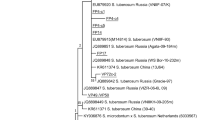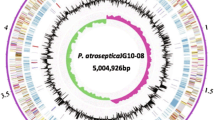Abstract
Pectobacterium wasabiae has a narrow host range, having previously only been associated with Japanese horseradish. However, recent characterisation of Pectobacterium causing soft rotting in New Zealand has identified putative P. wasabiae isolates pathogenic to potato. In this study, phylogenetic reconstruction of acnA and mdh DNA sequences and fluorescent amplified fragment length polymorphisms (fAFLP) were used to confirm the identity of the putative P. wasabiae isolates. Both methods clustered the potato isolates closely with the type strain for P. wasabiae, ICMP9121, and also differentiated them from other plant pathogenic enterobacteria. PCR, DNA hybridisation and hypersensitive response (HR) assays were subsequently used to investigate the presence in P. wasabiae of the type III secretion system (T3SS) as well as other virulence factors known to be involved in development of disease by enterobacteria. Although all P. wasabiae strains appeared to elicit a type III-dependent HR in tobacco, genes associated with the T3SS and the putative virulence factors HecB and DspE could not be detected. Thus, genetic characterisation of P. wasabiae confirmed that it is a naturally occurring pathogen on potato, which does not possess the same suite of virulence factors that are involved in the pathogenicity of other enterobacteria on this host.





Similar content being viewed by others
References
Avrova, A. O., Hyman, L. J., Toth, R. L., & Toth, I. K. (2002). Application of amplified fragment length polymorphism fingerprinting for taxonomy and identification of the soft rot bacteria Erwinia carotovora and Erwinia chrysanthemi. Applied and Environmental Microbiology, 68, 1499–1508.
Bell, K. S., Avrova, A. O., Holeva, M. C., Cardle, L., Morris, W., De Jong, W., et al. (2002). Sample sequencing of a selected region of the genome of Erwinia carotovora subsp. atroseptica reveals candidate phytopathogenicity genes and allows comparison with Escherichia coli. Microbiology, 148, 1367–1378.
Bell, K. S., Sebaihia, M., Pritchard, L., Holden, M. T., Hyman, L. J., Holeva, M. C., et al. (2004). Genome sequence of the enterobacterial phytopathogen Erwinia carotovora subsp. atroseptica and characterization of virulence factors. Proceedings of the National Academy of Sciences USA, 101, 11105–11110.
Bogdanove, A. J., Bauer, D. W., & Beer, S. V. (1998). Erwinia amylovora secretes DspE, a pathogenicity factor and functional AvrE homolog, through the Hrp (type III secretion) pathway. Journal of Bacteriology, 180, 2244–2247.
Boyd, E. F., Nelson, K., Wang, F. S., Whittam, T. S., & Selander, R. K. (1994). Molecular genetic basis of allelic polymorphism in malate dehydrogenase (mdh) in natural populations of Escherichia coli and Salmonella enterica. Proceedings of the National Academy of Sciences USA, 91, 1280–1284.
De Boer, S. H., & Sasser, M. (1986). Differentiation of Erwinia carotovora subsp. carotovora and E. carotovora subsp. atroseptica on the basis of cellular fatty acid composition. Canadian Journal of Microbiology, 32, 796–800.
Duarte, V., De Boer, S. H., Ward, L. J., & de Oliveira, A. M. R. (2004). Characterization of atypical Erwinia carotovora strains causing blackleg of potato in Brazil. Journal of Applied Microbiology, 96, 535–545.
Galán, J. E., & Collmer, A. (1999). Type III secretion machines: bacterial devices for protein delivery into host cells. Science, 284, 1322–1328.
Gallois, A., Samson, R., Ageron, E., & Grimont, P. A. D. (1992). Erwinia carotovora subsp. odorifera subsp. nov. associated with odorous soft rot of chicory. International Journal of Systematic Bacteriology, 42, 582–588.
Gardan, L., Gouy, C., Christen, R., & Samson, R. (2003). Elevation of three subsp. of Pectobacterium carotovorum to species level: Pectobacterium atrosepticum sp. nov., Pectobacterium betavasculorum sp. nov. and Pectobacterium wasabiae sp. nov. International Journal of Systematic and Evolutionary Microbiology, 53, 381–391.
Glasner, J. D., Marquez-Villavicencio, M., Kim, H. S., Jahn, C. E., Ma, B., Biehl, B. S., et al. (2008). Niche-specificity and the variable fraction of the Pectobacterium pan-genome. Molecular Plant Microbe Interactions, 21, 1549–1560.
Goto, M., & Matsumoto, K. (1987). Erwinia carotovora subsp. wasabiae subsp. nov. isolated from diseased rhizomes and fibrous roots of Japanese horseradish. International Journal of Systematic Bacteriology, 37, 130–135.
Holeva, M. C., Bell, K. S., Hyman, L. J., Avrova, A. O., Whisson, S. C., Birch, P. R., et al. (2004). Use of a pooled transposon mutation grid to demonstrate roles in disease development for Erwinia carotovora subsp. atroseptica putative type III secreted effector (DspE/A) and helper (HrpN) proteins. Molecular Plant Microbe Interactions, 17, 943–950.
Jaccard, P. (1908). Nouvelles recherches sur la distribution florale. Bulletin Societe Vaudoise de Sciences Naturelle, 44, 223–270.
Kim, H. S., Ma, B., Perna, N. T., & Charkowski, A. O. (2009). Phylogeny and virulence of naturally occurring type III secretion system-deficient Pectobacterium strains. Applied and Environmental Microbiology, 75, 4539–4549.
Ma, B., Hibbing, M. E., Kim, H. S., Reedy, R. M., Yedidia, I., Breuer, J., et al. (2007). Host range and molecular phylogenies of the soft rot enterobacterial genera Pectobacterium and Dickeya. Phytopathology, 97, 1150–1163.
Oliveira, A. M. R., Duarte, V., Silveira, J. R. P., & Moraes, M. G. (2003). Incidence of pectolytic erwinias associated with blackleg of potato in Rio Grande do Sul. Fitopatologia Brasilia, 28, 49–53.
Pérombelon, M. C. M. (2002). Potato diseases caused by soft rot erwinias: an overview of pathogenesis. Plant Pathology, 51, 1–12.
Pitman, A. R., Wright, P. J., Gailbraith, M. D., & Harrow, S. A. (2008). Biochemical and genetic diversity of pectolytic enterobacteria causing soft rot disease of potatoes in New Zealand. Australasian Plant Pathology, 37, 559–568.
Rantakari, A., Virtaharju, O., Vähämiko, S., Taira, S., Palva, E. T., Saarilahti, H. T., et al. (2001). Type III secretion contributes to the pathogenesis of the soft rot pathogen Erwinia carotovora: Partial characterization of the hrp gene cluster. Molecular Plant Microbe Interactions, 14, 962–968.
Rojas, C. M., Ham, J. H., Deng, W. L., Doyle, J. J., & Collmer, A. (2002). HecA, a member of a class of adhesins produced by diverse pathogenic bacteria, contributes to the attachment, aggregation, epidermal cell killing, and virulence phenotypes of Erwinia chrysanthemi EC16 on Nicotiana clevelandii seedlings. Proceedings of the National Academy of Sciences USA, 99, 13142–13147.
Rojas, C. M., Ham, J. H., Schechter, L. M., Kim, J. F., Beer, S. V., & Collmer, A. (2004). The Erwinia chrysanthemi EC16 hrp/hrc gene cluster encodes an active Hrp type III secretion system that is flanked by virulence genes functionally unrelated to the Hrp system. Molecular Plant Microbe Interactions, 17, 644–653.
Samson, R., Legendre, J. B., Christen, R., Fischer-Le Saux, M., Achouak, W., & Gardan, L. (2005). Transfer of Pectobacterium chrysanthemi (Burkholder et al. 1953) Brenner et al. 1973 and Brenneria paradisiaca to the genus Dickeya gen. nov. as Dickeya chrysanthemi comb. nov. and Dickeya paradisiaca comb. nov. and delineation of four novel species, Dickeya dadantii sp. nov., Dickeya dianthicola sp. nov., Dickeya dieffenbachiae sp. nov. and Dickeya zeae sp. nov. International Journal of Systematic and Evolutionary Microbiology, 55, 1415–1427.
Swofford, D. L. (2002). PAUP*. Phylogenetic Analysis Using Parsimony (*and other methods). Version 4. Sunderland: Sinauer.
Thompson, J. D., Gibson, T. J., Plewniak, F., Jeanmougin, F., & Higgins, D. G. (1997). The CLUSTALX windows interface: flexible strategies for multiple sequence alignment aided by quality analysis tools. Nucleic Acids Research, 24, 4876–4882.
Thomson, S. V., Hildebrand, D. C., & Schroth, M. N. (1981). Identification and nutritional differentiation of the Erwinia sugar beet pathogen from members of Erwinia carotovora and Erwinia chrysanthemi. Phytopathology, 71, 1037–1042.
Thomson, N. R., Thomas, J. D., & Salmond, G. P. C. (1999). Virulence determinants in the bacterial phytopathogen Erwinia. Methods in Microbiology, 29, 347–426.
Toth, I. K., Avrova, A. O., & Hyman, L. J. (2001). Rapid identification and differentiation of the soft rot erwinias by 16S–23S intergenic transcribed spacer-PCR and restriction fragment length polymorphism analyses. Applied and Environmental Microbiology, 67, 4070–4076.
Vos, P., Hogers, R., Bleeker, M., Reijans, M., van de Lee, T., Hornes, M., et al. (1995). AFLP: a new technique for DNA fingerprinting. Nucleic Acids Research, 23, 4407–4414.
Yahiaoui-Zaidi, R., Jouan, B., & Andrivon, D. (2003). Biochemical and molecular diversity among Erwinia isolates from potato in Algeria. Plant Pathology, 52, 28–40.
Yang, C. H., Gavilanes-Ruiz, M., Okinaka, Y., Vedel, R., Berthuy, I., Boccara, M., et al. (2002). hrp genes of Erwinia chrysanthemi 3937 are important virulence factors. Molecular Plant Microbe Interactions, 15, 472–480.
Yap, M. N., Barak, J. D., & Charkowski, A. O. (2004). Genomic diversity of Erwinia carotovora subsp. carotovora and its correlation with virulence. Applied and Environmental Microbiology, 70, 3013–3023.
Young, J. M., & Park, D. C. (2007). Relationships of plant pathogenic enterobacteria based on partial atpD, carA, and recA as individual and concatenated nucleotide and peptide sequences. Systematic and Applied Microbiology, 30, 343–354.
Zeigler, D. R. (2003). Gene sequences useful for predicting relatedness of whole genomes in bacteria. International Journal of Systematic and Evolutionary Microbiology, 53, 1893–1900.
Acknowledgements
This work was funded by the New Zealand Foundation for Research, Science & Technology through contract CO2X0501, the Better Border Biosecurity (B3) programme (www.b3nz.org) and by the Tertiary Education Commission. We are grateful to Ian Scott for his helpful advice in the writing of this manuscript.
Author information
Authors and Affiliations
Corresponding author
Rights and permissions
About this article
Cite this article
Pitman, A.R., Harrow, S.A. & Visnovsky, S.B. Genetic characterisation of Pectobacterium wasabiae causing soft rot disease of potato in New Zealand. Eur J Plant Pathol 126, 423–435 (2010). https://doi.org/10.1007/s10658-009-9551-y
Received:
Accepted:
Published:
Issue Date:
DOI: https://doi.org/10.1007/s10658-009-9551-y




